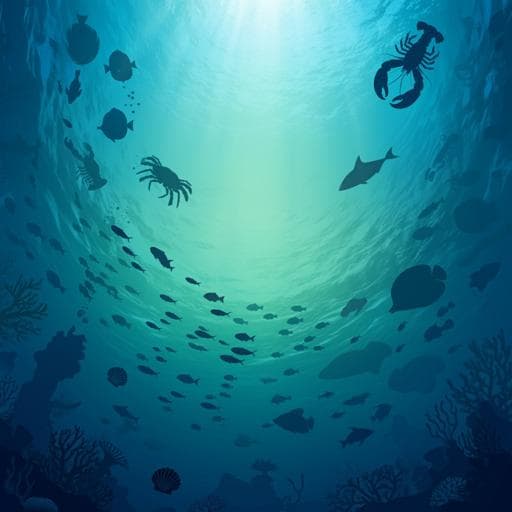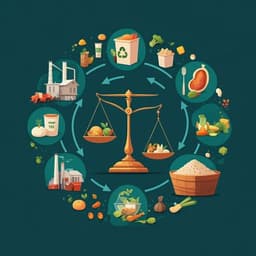
Food Science and Technology
Aquatic food loss and waste rate in the United States is half of earlier estimates
D. C. Love, F. Asche, et al.
Dive into the intriguing world of aquatic food loss and waste, a critical sustainability challenge uncovered by researchers David C. Love, Frank Asche, and their esteemed colleagues. Discover how this study sheds light on significant differences in food loss among species and highlights the necessity for global cooperation to tackle this pressing issue.
~3 min • Beginner • English
Introduction
Aquatic foods are important to global diets, yet their loss and waste patterns are not well characterized across full supply chains. Earlier widely used FAO estimates (2011) suggested high aquatic FLW (50% in North America), but were based on assumptions that excluded aquaculture, ignored trade, focused primarily on retail channels, and used indirect methods for consumer waste. Given that aquaculture now supplies ~50% of global edible aquatic production and aquatic foods are the most traded major food group, these assumptions likely bias estimates. The study aims to generate updated, more accurate FLW estimates for the United States aquatic food supply by disaggregating by species, production method (capture vs aquaculture), origin (domestic vs imported), and supply chain stage from production through consumption (2014–2018). The purpose is to inform progress toward UN SDG 12.3 and guide targeted interventions across a complex, multi-country supply chain.
Literature Review
The 2011 FAO study estimated that 35% of aquatic foods are lost and wasted globally and 50% in North America, higher than many terrestrial food categories. However, these estimates omitted aquaculture, did not account for international trade, assumed all aquatic foods were sold via retail only, and relied on indirect consumer waste estimation. FAO’s 2019 updates grouped aquatic foods with other animal products and provided limited aquatic-specific data. Existing literature is dominated by case studies in small-scale capture fisheries in LMICs, with large gaps for aquaculture species, large-scale fisheries, and high-income country supply chains. Prior US studies often aggregate aquatic foods with meat and poultry, masking seafood-specific dynamics (perishability, odors, production diversity, long-distance transport). More recent, disaggregated studies (e.g., China estimate ~20%) indicate earlier global estimates may be overstated, underscoring the need for detailed, species- and stage-specific approaches.
Methodology
Scope and boundary: The study estimated FLW for the US aquatic food supply from 2014–2018, beginning at production (domestic and imported supply chains) and ending at consumption in the United States or removal from the human food supply. Analyses follow FAO framework recommendations and convert products to raw edible weight. Byproducts and inedible parts (heads, frames, tails) not sold as human food were excluded.
Data coverage: At production and processing, the top ten species groups consumed in the US (shrimp, canned tuna, salmon, Alaska pollock, tilapia, catfish, Pangasius, crab, cod, clams) representing ~89% of supply were analyzed; remaining species were grouped as ‘other’. In downstream stages (distribution, retail, food service, consumption), aquatic foods were combined for flow tracking, then split into retail (consumed at home) and food service (consumed away from home).
Loss definitions: Physical loss is product removed from the human food supply. Quality loss is product sold at an economic loss (discounted, downgraded, donated) but remaining potentially edible for humans. Quality loss was assessed at production, processing, and distribution; not available at retail, food service, or consumer stages.
Primary data collection: Surveys and semi-structured interviews were conducted with producers (n=24) and processors (n=20) in key sectors supplying the US: Vietnam farmed shrimp and Pangasius; US farmed channel/hybrid catfish; Norway farmed Atlantic salmon; US wild Alaska sockeye salmon; US wild Alaska pollock; and Pacific canned tuna. Most quantitative data were collected in person in 2019. Distributors were surveyed (n=5; 4 US, 1 Canada) on returns, unsold inventory, and recalls. Retail loss rates were compiled from national Food Marketing Institute surveys (2014, 2016, 2018; total n=90 chains) and weighted by national sales shares of fresh, frozen, and shelf-stable seafood. Food service losses were drawn from a non-systematic review of 13 studies across eight countries, covering kitchen and plate waste. Consumer at-home waste was measured via a US food diary survey of seafood consumers (n=70; June–July 2019), weighted by income to match seafood consumer demographics; away-from-home waste used the food service literature.
Secondary data: FDA and USDA import refusal data were used to augment processor loss estimates. FDA recall data were used to estimate distribution-stage losses. National retail sales and dietary intake datasets supported weighting for product forms and at-home vs away-from-home consumption shares.
Computation and weighting: For each species group and production method, loss rates were derived and then weighted by the share of supply from aquaculture vs capture fisheries and imported vs domestic origin. Species group loss rates were then weighted by each group’s contribution to total US supply to derive national estimates. Stage-specific losses (quantity) were obtained by multiplying loss rates by quantities available at that stage, using raw edible weight conversions. The total US supply was based on average per capita availability (2014–2018, NMFS) times the US population, plus pre-harvest losses.
Key assumptions and distinctions: In aquaculture, mortalities of harvestable-sized animals prior to harvest were counted as producer-level food loss (edible fraction of biomass). In capture fisheries, only harvested discards were counted as loss; unobserved mortalities of unharvested wild fish were not included. Downstream stages were assumed to handle processed edible forms; respondents were instructed to report losses of edible products only.
Qualitative data: Semi-structured interviews with producers (n=19), processors (n=14), wholesalers (n=4), retail chains (n=2), and food service businesses (n=5) (2019–2021) explored causes of FLW and mitigation strategies. Notes were analyzed using MAXQDA.
Ethics: Approvals from Johns Hopkins BSPH IRB (no. 8345) and University of Florida IRB (no. 201901559).
Key Findings
- Overall FLW: The US edible aquatic food supply averaged 2.73 million metric tonnes (MMT) per year (2014–2018). Estimated physical loss and waste totaled 0.62 MMT/yr, or 22.7% of supply. This is 43–55% lower than prior estimates for North America (50%) and the US (40–47%). Quality loss (where measured) totaled ~0.23 MMT/yr (9.3%).
- Stage breakdown (physical loss): Production and consumption each contributed roughly one-third of total physical loss. Processors contributed ~7.9% and distributors ~5.0% of total physical loss. Consumer-facing stages together contributed ~20.9% (retail 7.5%, food service 13.4%).
- Stage-specific loss rates and quantities:
• Production: 7.5% loss rate; 0.21 MMT/yr physical loss; 3.4% quality loss rate; 0.09 MMT/yr quality loss.
• Processing: 1.8% loss rate; 0.05 MMT/yr physical loss; 3.1% quality loss rate; 0.09 MMT/yr quality loss.
• Distribution: 1.2% loss rate; 0.03 MMT/yr physical loss (60% returns, 35% unsold, 5% recalls); 2.0% quality loss rate; 0.05 MMT/yr quality loss (69% returns, 31% unsold).
• Retail: 2.9% loss rate; 0.05 MMT/yr physical loss; losses by product form: 81% fresh, 11% frozen, 8% shelf-stable.
• Food service (kitchen losses): 9.9% loss rate; 0.08 MMT/yr physical loss.
• Consumption: Total consumer loss ~0.20 MMT/yr; at-home 0.13 MMT/yr (8.5% rate); away-from-home 0.07 MMT/yr. Reported reasons for discards at home included not wanting leftovers (18%), buying too much (16%), slime and odors (>6% each). Saving money (64%) was the top motivation to reduce waste.
- Sector differences: Capture fisheries vs aquaculture at production had physical loss rates of 5.9% vs 8.2% and quality loss rates of 2.6% vs 3.8%, respectively, reflecting definitional differences (inclusion of aquaculture mortalities of harvestable animals) and distinct management levers.
- Species contributions: The largest contributors to production losses were shrimp, catfish (including Pangasius), salmon, canned tuna, and tilapia—also the top US-consumed species. In processing, shrimp, tilapia, canned tuna, and catfish dominated losses. Literature synthesis showed high physical loss rates for spiny lobster in Indonesia (27%), dagaa in East Africa (23%), global shrimp (22%), and Sardinella in Ghana (18); aquaculture examples included Pangasius (Vietnam, 18%), shrimp (Vietnam, 12%), and tilapia (China, 11%). Alaska pollock (US) showed among the lowest losses (0.35% physical; 1.8% quality).
- Trade and origin: Imports accounted for 78–81% of production-stage losses and ~26% of total FLW across the entire chain, exceeding imports’ 72% share of US supply. Higher upstream losses in LMICs and the dominance of aquaculture among imports contributed to this pattern.
- Interventions: Key opportunities include selective fishing gears and improved handling/cold chain in capture fisheries; disease prevention, water quality management, and improved genetics in aquaculture; processor upcycling and market outlets for downgraded products; improved logistics and communication at distribution; inventory management, discounting, and storage practices at retail and food service; and consumer education plus product innovations (frozen/shelf-stable formats) to extend shelf life.
Discussion
The study answers the need for updated, disaggregated FLW estimates for aquatic foods in a highly traded, species-diverse US supply. By integrating primary data across top species and multiple supply chain stages with secondary datasets and explicit treatment of aquaculture, trade, food service, and consumer behavior, the authors demonstrate that total aquatic FLW (22.7%) is substantially lower than prior generalized estimates. Losses concentrate at production (notably aquaculture mortalities and fishery discards) and consumption (especially at-home waste), pointing to where interventions can be most impactful. The work clarifies distinctions between physical and quality losses and reveals how market practices and standards can shift the locus of loss across the chain (e.g., moving from canned to fresh formats increases downstream risks). It highlights global implications due to the high import share and suggests that multinational, capacity-building approaches are necessary to address losses associated with imported products. The findings provide actionable insight for businesses, certification schemes, and policy efforts to prioritize interventions, track progress toward SDG 12.3, and improve sustainability outcomes across blue food systems.
Conclusion
This study provides a comprehensive, supply-chain-wide estimate of US aquatic food loss and waste, finding a total physical loss rate of 22.7%—roughly half of earlier estimates—by explicitly accounting for aquaculture, trade, food service, and consumer stages and distinguishing physical from quality losses. Production (especially aquaculture) and consumption (especially at-home) are priority nodes for intervention. Recommended actions include aquaculture health and water quality improvements, better hatchery genetics, selective gear and improved cold chain in capture fisheries, processor upcycling, and enhanced inventory and storage practices in distribution, retail, and food service. Consumer-focused strategies—education on purchase, storage, and preparation, and increased availability of shelf-stable and frozen options—can reduce at-home waste. Addressing losses associated with imports requires multinational cooperation and incentives. Future research should expand high-quality primary data collection, particularly for aquaculture species, retail and food service quality losses, and consumer behavior; segment aquatic foods from meat in waste surveillance; explore gender-responsive approaches; and integrate FLW metrics into sustainability monitoring and labeling.
Limitations
Key limitations and sources of bias include: (1) Product form conversions and assumptions about what constitutes ‘edible’ in the US may not generalize to all populations or countries. (2) Trade code aggregation (e.g., shell-on vs shell-off bivalves) introduces uncertainty in origin- and form-specific weights. (3) Generalization from selected sectors and regions supplying the US may not capture all production contexts. (4) Distribution-stage sampling skewed toward specialty seafood wholesalers (fresh/live) and under-sampled broadline distributors (frozen/canned), potentially inflating distributor loss rates; however, distribution contributes a small share of overall FLW. (5) Food service estimates rely on literature (often not seafood-specific and partly non-US), introducing uncertainty. (6) Quality loss data were unavailable for retail, food service, and consumer stages. (7) Methodological differences between aquaculture and capture fisheries at production (counting aquaculture mortalities of harvestable-sized animals but not unharvested wild fish mortalities) complicate direct comparisons. Additionally, inedible byproducts and fish used as animal feed were excluded, aligning with a US-edible definition.
Related Publications
Explore these studies to deepen your understanding of the subject.







